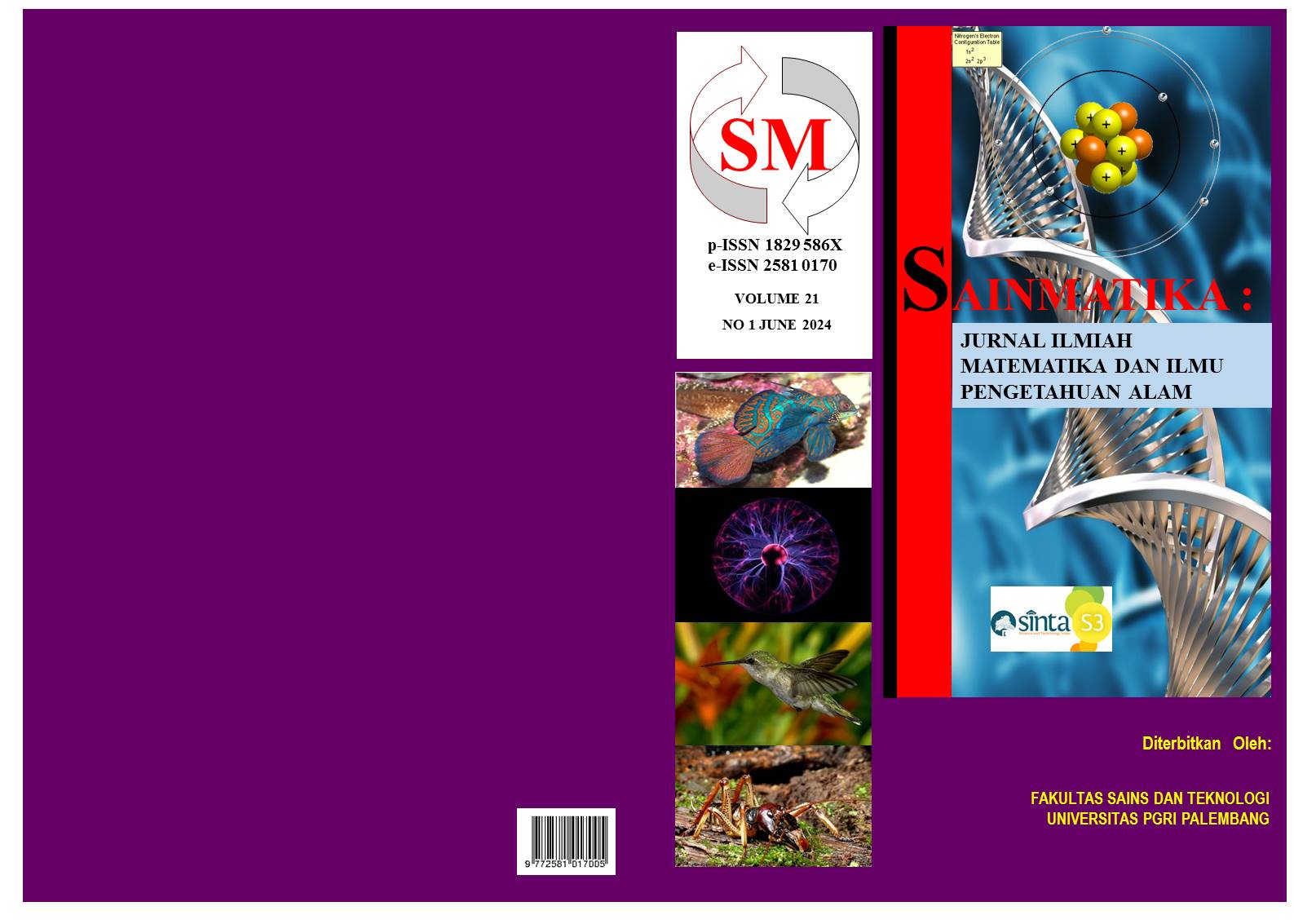Comparison of Alum and Poly Aluminum Chloride Coagulant Performance on Turbidity and pH of Lematang Enim PDAM Raw Water
DOI:
https://doi.org/10.31851/sainmatika.v21i1.13749Keywords:
Coagulant, Aluminum Sulfate, PAC, turbidity, pHAbstract
Raw water is natural water found in lakes, rivers, streams, and underground sources before any treatment or purification processes. It typically contains various impurities, such as suspended solids, organic matter, pathogens, and dissolved minerals, which need to be removed to make it safe for consumption. Aluminum Sulfate and Poly Aluminum Chloride (PAC) are two commonly used chemicals in the treatment of raw water to remove impurities and make it suitable for drinking, industrial, or agricultural purposes. These chemicals play crucial roles in the purification process by aiding in the coagulation and flocculation of contaminants, which facilitates their removal through filtration. Study on raw water treatment using Aluminum Sulphate and Poly Aluminum Chloride (PAC) coagulants was carried out at Talang Jawa IPA PDAM Lematang Enim of Muara Enim District by taking raw water samples from Talang Jawa Intake and Pelita Sari Intake. This study aimed to find out the right type and dose of coagulant in the raw water treatment process. he test parameters were turbidity and pH values. The research was conducted using a jar test to determine the dose of coagulant. The results showed the use of solid PAC was more effective for both intakes. The optimum coagulant dose is 20 ppm PAC in the raw water of Talang Jawa intake and Pelita Sari intake with turbidity of 2.62 NTU and 4.15 NTU and pH of 7.8 and 7.6.
References
Afiatun, E., Pradiko, H., Wahyuni, S., & Pamungkas, O. F. (2021). Analysis of modification sedimentation process at communal scale water treatment with electrocoagulation technique. IOP Conference Series: Earth and Environmental Science, 802(1). https://doi.org/10.1088/1755-1315/802/1/012044
Azhar, A. A., Haron, N. F., & Ismail, H. B. (2022). The Efficiency Assessment of Poly-Aluminium Chloride (PAC) in Water Treatment Plant Process: A Case Study at Sultan Iskandar Water Treatment Plant, Johor. Journal of Sustainable Civil Engineering and Technology, 1(2), 8–16. https://doi.org/10.24191/jscet.v1v2.8-16
Bakri, B., Selintung, M., Hamdani, R. N., Ihsan, M., & Arai, Y. (2019). The Effectiveness of PAC and Chitosan Usage in Jeneberang River Raw Water Treatment. IOP Conference Series: Materials Science and Engineering, 676(1). https://doi.org/10.1088/1757-899X/676/1/012028
Beatrice, C. A. G., Oliveira, A. D., Passador, F. R., & Pessan, L. A. (2016). Sulfonated poly(ether imide)/aluminium nanocomposites for hydrogen storage. AIP Conference Proceedings, 1779. https://doi.org/10.1063/1.4965495
El-Sayed Abdel-Raouf, M., Elsayed Abdel-Raouf, M., Maysour, N. E., Kamal Farag, R., Mahmoud Abdul-Raheim, A.-R., & Author, C. (2019). International Journal of Environment & Agricultural Science Wastewater Treatment Methodologies, Review Article. Int J Environ & Agri Sci, an Open Access Journal, 2019(1), 18.
Feihrmann, A. N. C., Baptista, A. T. A., Lazari, J. P., Silva, M. O., Vieira, M. F., & Vieira, A. M. S. (2017). Evaluation of coagulation/floculation process for water treatment using defatted cake from Moringa oleifera. Chemical Engineering Transactions, 57, 1543–1548. https://doi.org/10.3303/CET1757258
Feriyanto, Y. E., Zulfikar, S. P., & Dedy. (2021). Optimization of Sedimentation System through AHP and AHP-TOPSIS Methods in Water Treatment Steam Power Plant. IOP Conference Series: Materials Science and Engineering, 1096(1), 012102. https://doi.org/10.1088/1757-899x/1096/1/012102
Gupta, N., Pandey, P., & Hussain, J. (2017). Effect of physicochemical and biological parameters on the quality of river water of Narmada, Madhya Pradesh, India. Water Science, 31(1), 11–23. https://doi.org/10.1016/j.wsj.2017.03.002
Liu, S., Zhuang, X., & Wang, C. (2021). Application of polyaluminium chloride coagulant in urban river water treatment influenced the microbial community in river sediment. Water (Switzerland), 13(13). https://doi.org/10.3390/w13131791
Maldhure, A., Khadse, G., & Labhasetwar, P. (2022). Effect of clariflocculator and pulsator based sedimentation technology and poly-aluminium chloride coagulant type on the efficiency of the water treatment plant. Water Supply, 22(3), 2793–2802. https://doi.org/10.2166/WS.2021.434
Mustafa, A. *, Thahir, R., Teknik, J., Politeknik, K., & Samarinda, N. (2013). PENGURANGAN KADAR H2S DARI BIOGAS LIMBAH CAIR RUMAH SAKIT DENGAN METODE ADSORPSI. 2(1), 1–6.
Orooji, N., Mohammadi, M. J., Takdastan, A., Feizi, R., & Kargari, A. (2020). Investigation of the efficiency of removing turbidity, aluminum, and total organic compounds by using poly-aluminum chloride and chitosan from the water of karoon river, Iran. Desalination and Water Treatment, 200, 82–89. https://doi.org/10.5004/dwt.2020.26055
Sadkhan, F. Y., Hussain, S. K., & Khuder, A. H. (2021). Friction Spot Joining (FSpJ) process of Aluminium AA6061-T6/Poly Vinly Chloride (PVC). IOP Conference Series: Materials Science and Engineering, 1105(1), 012043. https://doi.org/10.1088/1757-899x/1105/1/012043
Sisnayati, S., Wnitoto, E., Yhopie, Y., & Aprilyanti, S. (2021). PERBANDINGAN PENGGUNAAN TAWAS DAN PAC TERHADAP KEKERUHAN DAN pH AIR BAKU PDAM TIRTA MUSI PALEMBANG. Jurnal Redoks, 6(2), 107–116. https://doi.org/10.31851/redoks.v6i2.5841
Sisnayati, Said, M., Nasir, S., & Priadi, D. P. (2018). The utilization of ceramic membrane for treating of water from Sekanak River Palembang to produce clean water. International Journal on Advanced Science, Engineering and Information Technology, 8(5), 2114–2121. https://doi.org/10.18517/ijaseit.8.5.4724
Syaichurrozi, I., Jayanudin, J., Sari, L. N., & Apriantika, A. P. (2022). Comparison of Alum and Poly Aluminium Chloride at Various Doses in Coagulation Process on Color Removal of Palm Oil Mill Effluent. Jurnal Bahan Alam Terbarukan, 11(2), 77–84. https://doi.org/10.15294/jbat.v11i2.38885
Thaldiri, N. H., Mohd. Hanafiah, M., & Abdul Halim, A. (2017). Effect of Modified Micro-Sand, Poly-Aluminium Chloride and Cationic Polymer on Coagulation-Flocculation Process of Landfill Leachate. Environment & Ecosystem Science, 1(1), 18–21. https://doi.org/10.26480/ees.01.2017.18.21
Widiyanti, S. E. (2019). Optimization of Coagulation-Flocculation Process for Tello River Water Treatment Using Poly Aluminum Chloride and Aluminum Sulfate. IOP Conference Series: Materials Science and Engineering, 676(1). https://doi.org/10.1088/1757-899X/676/1/012026
Zand, A. D., & Hoveidi, H. (2015). Comparing aluminium sulfate and poly-aluminium chloride (PAC) performance in turbidity removal from synthetic water. Journal of Applied Biotechnology Reports, 2(3), 287–292.
Zhou, F. S., Hu, B., Cui, B. L., Liu, F. B., Liu, F., Wang, W. H., Liu, Y., Lu, R. R., Hu, Y. M., Zhang, Y. H., & Wu, J. G. (2014). Preparation and characteristics of polyaluminium chloride by utilizing fluorine-containing waste acidic mother liquid from clay-brine synthetic cryolite process. Journal of Chemistry, 2014. https://doi.org/10.1155/2014/274126

Downloads
Published
Issue
Section
License

This work is licensed under a Creative Commons Attribution-NonCommercial-ShareAlike 4.0 International License.








